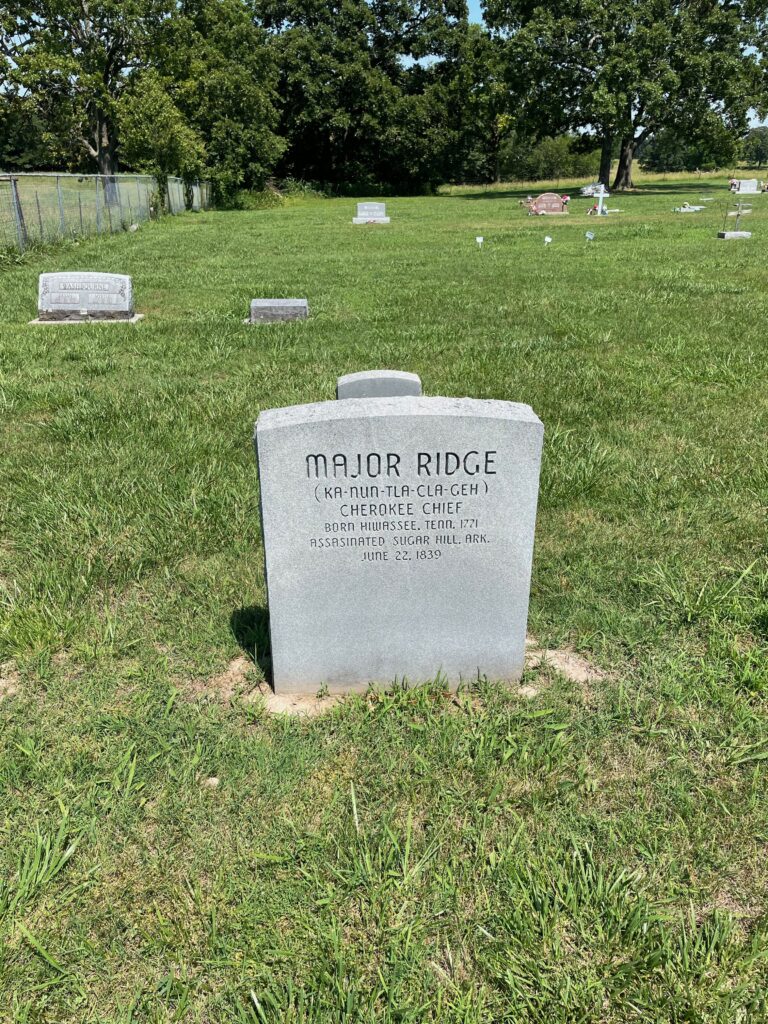Erik Visits an American Grave, Part 1,389
This is the grave of Major Ridge.

Born in 1771, somewhere around Hiwassee, Tennessee, Ridge grew up in the Cherokee elite in a period of great change. His father was full-blooded Cherokee, his mother part Scottish, which had become very common by this time. He became a major warrior, fighting the Americans in the genocidal wars after the American Revolution and gained a lot of respect in the tribe over these years, though there were also violent factions within the tribe that led to a lot of killing and Ridge was quite involved in them. He married a part-Scottish, part-Cherokee woman, they had a son with the English name of John and they wanted to get him educated in the American fashion, so they sent him to Connecticut.
Such things were not uncommon in the Cherokee elite. Of all the major tribes, probably none had done as much to follow English-American guidelines about maintaining their lands than the Cherokee. They always had forms of slavery, but they adopted chattel slavery and created cotton plantations with African slaves in order to emulate the South. They reduced raiding and moved to farming. Many converted to Christianity, learned English, and received American educations. None of this mattered of course. The idea from whites that the tribes could hold onto their lands by becoming “civilized” was all bullshit. They simply assumed the tribes could never do those things and so they could take their land at will. Even when the tribes did try to do this, it just didn’t matter.
This was the world Major Ridge, as he was known in English after he fought with Andrew Jackson against the Creeks in 1814, lived in. He bought African slaves, built an American-style plantation house, etc. He himself could not read or write, but again, he made sure the younger generation could. When Tecumseh came to visit the Cherokee and covert them to his pan-Indian cause of rejecting white society entirely, Ridge threatened to kill him. His eggs were in one basket and would stay there.
But it didn’t work. Ridge finally became convinced that there was no hope of living with whites. He was basically right about this of course but the question within the Cherokee was whether it made more sense to move somewhere else or stay and fight it out. At least you would die on your lands with your ancestors. Ridge did not agree. He and his son John became the leaders of the pro-Removal faction, taking the government’s offer of lands in Indian Territory as the best opportunity they had. I can’t exactly blame them for this, but I certainly can’t blame the other side who wanted to stay and fight either. It was just a terrible, horrible, no good situation for the Cherokee. And it tore the tribe apart.
So in 1835, Ridge signed the Treaty of New Echota, which against the will of the majority of the Cherokee, signed over their lands and forced them to move west. This was no democracy, that’s for sure. Ridge was also looking out for his own interests, which allowed him to move slaves with him and rebuild his plantation. Ridge moved in 1837, the rest of the Cherokee except those who fled high into the North Carolina mountains, were forcibly removed in 1838. Ridge actually chose land away from the rest of the Cherokee, knowing that they would try and kill him. And that’s exactly what they did. Shortly after Removal, in 1839, the faction under the resistance leader John Ross, had their revenge on the leaders of the Removal faction, killing John and Major Ridge, as well as Eilas Boudinot. Major Ridge was shot in an ambush while riding along a road on his horse. He was approximately 67 years old.
Major Ridge is buried in Polson Cemetery, Delaware County, Oklahoma.
If you would like this series to visit other prominent Native leaders of the 19th century, you can donate to cover the required expenses here. Red Cloud is in Pine Ridge, South Dakota and Chief Joseph is in Nespelem, Washington. Previous posts in this series are archived here and here.


